A New Monitoring Method for the Water-Filled Status of Check Dams Using Remote Sensing and Deep Learning Techniques
Abstract
1. Introduction
2. Construction and Optimization of an Object Detection Model Based on the YOLOv3 Algorithm
2.1. Optimization of Applicability for Large-Scale Remote Sensing Image Detection
2.2. Coordinate Transformation
2.3. Optimization of Multi-Model Sequential Detection
3. Detection Model Training and Validation for Water-Filled Check Dams
3.1. Model Training
3.2. Model Validation: Case I
3.3. Model Validation: Case II
4. Discussion
5. Conclusions
- (1)
- By constructing and optimizing the YOLOv3 object detection model, this study established a fully automated monitoring technique for the water-filled status of check dams using the high spatial resolution remote sensing imagery. After model training, the evaluation of the model test results using five metrics, i.e., precision, recall, average precision (AP), F1-score, and mean average precision (mAP), indicates that the average precision for the check dam and water-filled check dam detection models reached 90.27% and 91.89%, respectively.
- (2)
- The check dams in the Jiuyuangou and Xiwuselang small watersheds were used as practical cases to validate the proposed monitoring technique for the water-filled status of check dams. The monitoring result based on remote sensing images in 2021 shows a good agreement with the actual number of check dams. This confirms the feasibility and reliability of the remote sensing-based monitoring technique for the water-filled status and safety management of check dams using the YOLOv3 algorithm and the optimized implementation procedure.
Author Contributions
Funding
Data Availability Statement
Conflicts of Interest
Abbreviations
| NDVI | Normalized difference vegetation index |
| TM | Thematic mapper |
| GIS | Geographic information system |
| YOLOv3 | You only look once version 3 |
| YOLO | You only look once |
| SSD | Single-shot multibox detector |
| R-CNN | Region-based convolution neural network |
| TIFF | Tag image file format |
| JPG | Joint photographic expert group |
| GDAL | Geospatial data abstraction library |
| VOC | Visual object class |
| CDDM | Check dam detection model |
| WF-CDDM | Water-filled check dam detection model |
| PMS | Panchromatic/multi-spectral |
References
- Niu, Y.G.; Wang, Y.; Li, Y.Q.; Zhang, H.X.; Peng, S.M. Research on water security layout and measures for ecological protection and high-quality development in the Yellow River Basin. Yellow River 2021, 43, 1–6. [Google Scholar]
- Cai, Q. Soil erosion and management on the Loess Plateau. J. Geogr. Sci. 2001, 11, 53–70. [Google Scholar] [CrossRef]
- Wei, X.; Li, Z.B.; Wu, J.H.; Li, B.B.; Du, Z. Discussion on several conceptual issues in the research of check dam damaged by floods. Res. Soil Water Conserv. 2007, 14, 154–156+159. [Google Scholar]
- Li, Z.G.; Cheng, H.; Fang, N.F.; Zeng, Y. Carbon sequestration, emission reduction, and capacity evaluation of check dams. J. Soil Water Conserv. 2023, 37, 1–6. [Google Scholar]
- Lucas-Borja, M.E.; Piton, G.; Yu, Y.; Castillo, C.; Zema, D.A. Check dams worldwide: Objectives, functions, effectiveness and undesired effects. Catena 2021, 204, 105390. [Google Scholar] [CrossRef]
- Liu, Y.L.; Wang, B.C. Strategic considerations for check dam construction in the Loess Plateau. China Soil Water Conserv. 2020, 2020, 48–52. [Google Scholar] [CrossRef]
- Wei, Y.H.; Wang, Z.J.; He, Z.; Yu, W.J.; Li, Y.J.; Jiao, J.Y. Investigation and evaluation of check dam damaged condition in the Yanhe River Basin during continuous rainstorms in July 2013. Bull. Soil Water Conserv. 2015, 35, 250–255. [Google Scholar]
- Wang, N.; Chen, Y.X.; Bai, L.C.; Wang, H.L.; Jiao, J.Y. Investigation of soil erosion in small watersheds caused by the “7·26” extreme rainstorm in Zizhou County, Northern Shaanxi Province. Bull. Soil Water Conserv. 2017, 37, 338–344. [Google Scholar]
- Zhang, Z.A.; Hou, J.M.; Liu, Z.Y.; Ma, L.P.; Li, Z.B.; Li, X.G. Numerical simulation on influence of check dam deposition on dam overtopping flood. J. Water Resour. Water Eng. 2019, 30, 148–153+158. [Google Scholar]
- Gong, X.H.; Zhang, Q.; Li, F. Application of fuzzy analytic hierarchy process in the risk assessment of check dams. J. Water Resour. Water Eng. 2022, 33, 131–137+147. [Google Scholar]
- Ministry of Water Resources of the People’s Republic of China. Notification on the issuance of construction and management methods for check dam projects in the Loess Plateau by the Ministry of Water Resources and the National Development and Reform Commission. Gazette Minist. Water Resour. People’s Repub. China 2022, 12–15. [Google Scholar]
- Xu, S.X. Deployment of the risk removal and reinforcement of dangerous check dams and engineering flood safety in the Loess Plateau region by the Ministry of Water Resources. China Soil Water Conserv. 2016, 409, 1-1. [Google Scholar] [CrossRef]
- SL/T 804-2020; Technical Specification for Check Dams. Ministry of Water Resources of the People’s Republic of China, China Water & Power Press: Beijing, China, 2021.
- Ministry of Water Resources of the People’s Republic of China. Notification on conducting risk and hazard investigations for medium and large check dams in the Loess Plateau region by the Ministry of Water Resources. Gazette Minist. Water Resour. People’s Repub. China 2021, 28–29. [Google Scholar]
- Central Committee of the Communist Party of China and the State Council. Guidelines for ecological protection and high-quality development in the Yellow River Basin. China Water Resour. 2021, 927, 3–16. [Google Scholar]
- Luo, X.C. Current status and development strategies for check dam construction in the Loess Plateau. China Soil Water Conserv. 2016, 414, 24–25. [Google Scholar] [CrossRef]
- Gao, Y.T.; Yang, S.J.; Dong, Y.L.; Ma, T.; Guo, J. Application of 3D laser scanning technology in the safety monitoring of gully banks of check dams. China Soil Water Conserv. 2021, 476, 62–64. [Google Scholar]
- Wang, Y.F.; Fu, B.J.; Hou, F.R.; Lv, Y.H.; Lu, X.P.; Song, C.J.; Luan, Y. Estimation of sediment volume trapped by check-dam based on differential GPS technique. Trans. Chin. Soc. Agric. Eng. 2009, 25, 79–83. [Google Scholar]
- Ma, S.Z.; Xu, J.Z.; He, M.Y.; Ding, L. Design and application of an automatic safety monitoring system for check dams in Henan Province. Bull. Soil Water Conserv. 2020, 40, 112–117. [Google Scholar]
- Yu, S.; Li, Y.Z.; Yao, X.F.; Wang, Z.J.; Yin, P.H.; Geng, S. Research and application of a risk warning and prevention platform for check dam systems. Bull. Soil Water Conserv. 2023, 43, 84–91. [Google Scholar]
- Li, Y.J.; Su, J.; Zhang, W. Monitoring practices in Yinzigou small watershed. China Soil Water Conserv. 2010, 341, 62–63. [Google Scholar]
- Li, B.Y.; Feng, Q.Y.; He, H.B.; Chen, L.; Chen, L.D. Extraction and analysis of feature information of typical small watershed check dams in the Loess Plateau gully region based on UAV tilt photogrammetry technology. J. Soil Water Conserv. 2023, 37, 91–96+103. [Google Scholar]
- Wang, Y.W.; Zhou, B.; Ma, T.; Tian, J.H.; Gao, Y.Y. Application of low-altitude UAV remote sensing technology in monitoring soil and water resources of check dams. China Soil Water Conserv. 2019, 10, 64–66. [Google Scholar]
- Mi, Z.J.; Mu, X.M.; Zhao, G.J. Extraction of check dam in the Huangfuchuan watershed based on multi-sources data. Arid Land Geogr. 2015, 38, 52–59. [Google Scholar]
- Zhang, Q.F.; Sun, C.J.; Xiang, Y.Y.; Li, J.; Liu, X.; Liang, J.R. Study on the characteristics of check dam land resources in soil erosion-sensitive areas of the middle reaches of the Yellow River based on remote sensing information. J. Earth Environ. 2022, 13, 357–368+379. [Google Scholar]
- Yang, X.; Xiang, Y.; Wang, Y.K.; Shen, G.Z. A dam safety state prediction and analysis method based on EMD-SSA-LSTM. Water 2024, 16, 395. [Google Scholar] [CrossRef]
- Hariri-Ardebili, M.A.; Mahdavi, G.; Nuss, L.K.; Lall, U. The role of artificial intelligence and digital technologies in dam engineering: Narrative review and outlook. Eng. Appl. Artif. Intell. 2023, 126 Pt A, 106813. [Google Scholar] [CrossRef]
- Skoulikaris, C.; Nagkoulis, N. A genetic algorithm’s novel rainfall distribution method for optimized hydrological modeling at basin scales. J. Hydroinform. 2024, 26, 1295–1312. [Google Scholar] [CrossRef]
- Li, Z.; Zheng, J.J.; Fu, Q.Y.; Li, Y. A Method for Extracting Water Level Inundation Lines of Large Reservoirs Based on Sub-Meter High-Resolution Remote Sensing Images. Patent CN111127405B, 4 August 2023. [Google Scholar]
- Zhang, J.L.; Fu, J.; Lei, T.J.; Li, X.Y.; Song, H.Q.; Chen, C.X. A Dynamic Monitoring System and Method for Reservoirs Based on Multi-Source Data. Patent CN112766146B, 29 November 2022. [Google Scholar]
- Yu, Y.F.; Li, Y.Q.; Wan, D.S.; Zhu, Y.L. A Method for Extracting Reservoir Water Bodies Based on Remote Sensing Images. Patent CN114821295A, 29 July 2022. [Google Scholar]
- Ozelkan, E. Water body detection analysis using NDWI indices derived from Landsat-8 OLI. Polish J. Environ. Stud. 2020, 29, 1759–1769. [Google Scholar] [CrossRef]
- Redmon, J.; Divvala, S.; Girshick, R.; Farhadi, A. You Only Look Once: Unified, real-time object detection. In Proceedings of the IEEE Conference on Computer Vision and Pattern Recognition, Las Vegas, NV, USA, 27–30 June 2016; pp. 779–788. [Google Scholar]
- Liu, W.; Anguelov, D.; Erhan, D.; Szegedy, C.; Reed, S.; Fu, C.Y.; Berg, A.C. SSD: Single shot multibox detector. In Proceedings of the European Conference on Computer Vision, Amsterdam, The Netherlands, 11–14 October 2016; Springer: Berlin/Heidelberg, Germany, 2016; pp. 21–37. [Google Scholar]
- Kim, T.Y.; Niaz, A.; Choi, J.S.; Choi, K.N. One-Stage Detection Model Based on Swin Transformer. IEEE Access 2024, 12, 60960–60972. [Google Scholar] [CrossRef]
- Girshick, R.; Donahue, J.; Darrell, T.; Malik, J. Rich feature hierarchies for accurate object detection and semantic segmentation. In Proceedings of the IEEE Conference on Computer Vision and Pattern Recognition, Columbus, OH, USA, 23–28 June 2014; pp. 580–587. [Google Scholar]
- Ren, S.; He, K.; Girshick, R.; Sun, J. Faster R-CNN: Towards real-time object detection with region proposal networks. IEEE Trans. Pattern Anal. Mach. Intell. 2017, 39, 1137–1149. [Google Scholar] [CrossRef]
- Redmon, J.; Farhadi, A. YOLOv3: An incremental improvement. arXiv 2018, arXiv:1804.02767. [Google Scholar]
- He, K.M.; Zhang, X.Y.; Ren, S.Q.; Su, J. Deep residual learning for image recognition. In Proceedings of the IEEE Conference on Computer Vision and Pattern Recognition, Las Vegas, NV, USA, 27–30 June 2016; pp. 770–778. [Google Scholar]
- Dong, W.X.; Liang, H.T.; Liu, G.Z.; Hu, Q.; Yu, X. Review of deep convolution applied to target detection algorithms. J. Front. Comput. Sci. Technol. 2022, 16, 1025–1042. [Google Scholar]
- Liu, Y.D.; Li, Q.Y.; Tan, H.; Qin, K.X. Application of the open-source GDAL library in image mosaicking. Digit. Technol. Appl. 2010, 2, 88–89. [Google Scholar]
- Zhao, Y.; Wang, S.Y.; Bi, H.Y.; Wang, H.; Yin, H. Key technologies for remote sensing image browsing based on GDAL. Comput. Eng. 2012, 38, 15–18+23. [Google Scholar]
- Ghosh, K.; Bellinger, C.; Corizzo, R.; Branco, P.; Krawczyk, B.; Japkowicz, N. The class imbalance problem in deep learning. Mach. Learn. 2024, 113, 4845–4901. [Google Scholar] [CrossRef]
- Tang, H.; Chen, J.; Zhang, W.; Guo, Z. Training acceleration method based on parameter freezing. Electronics 2024, 13, 2140. [Google Scholar] [CrossRef]


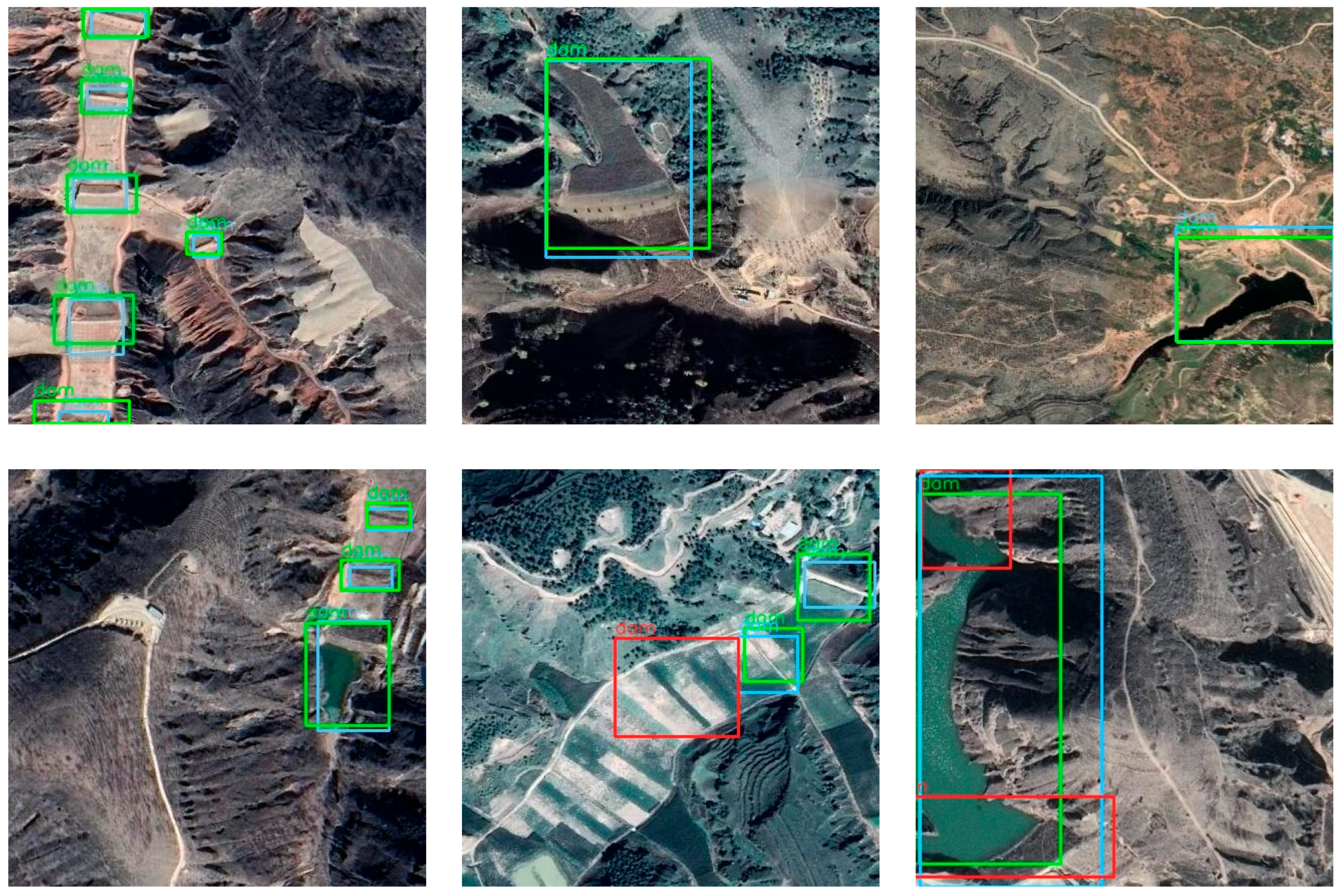
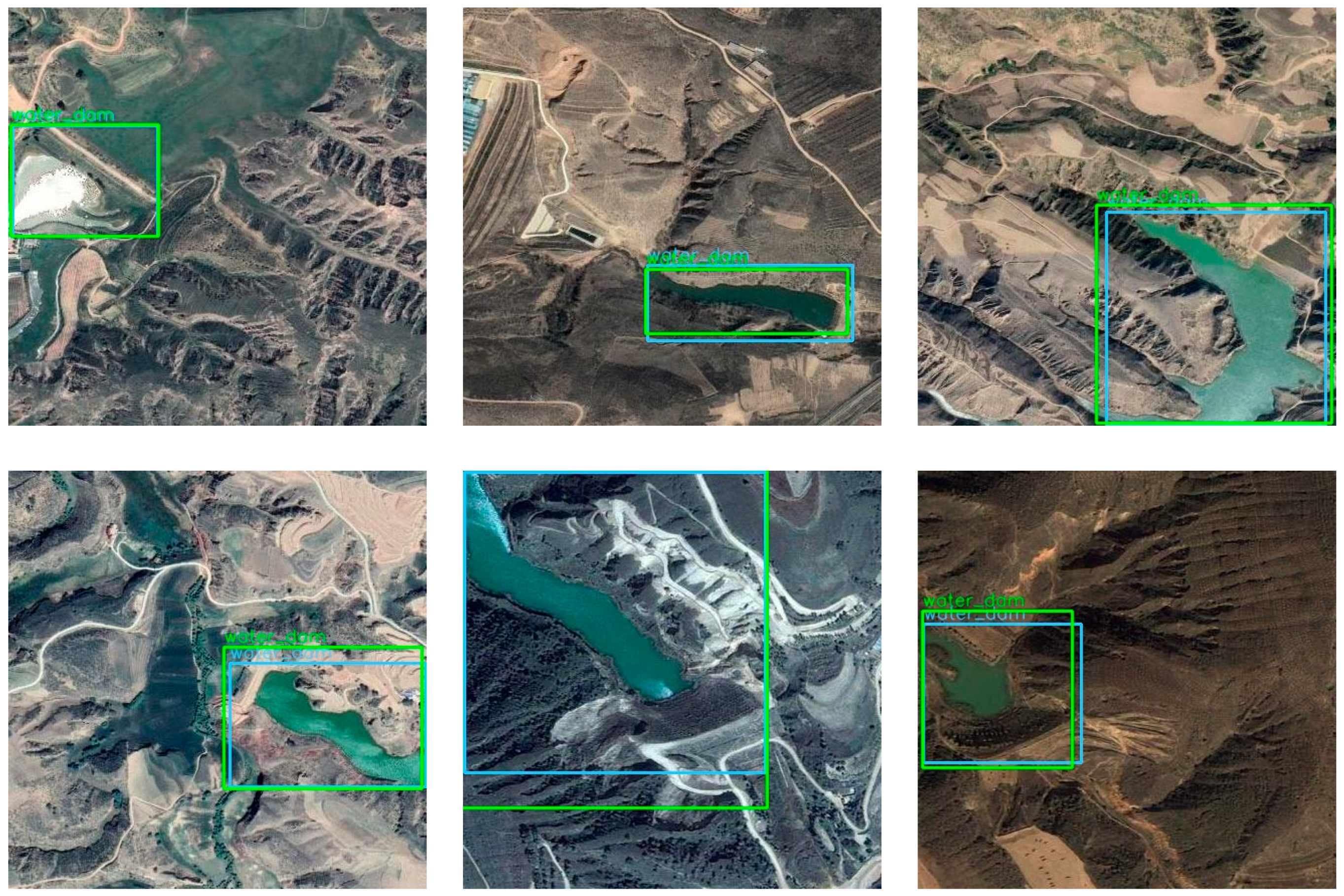

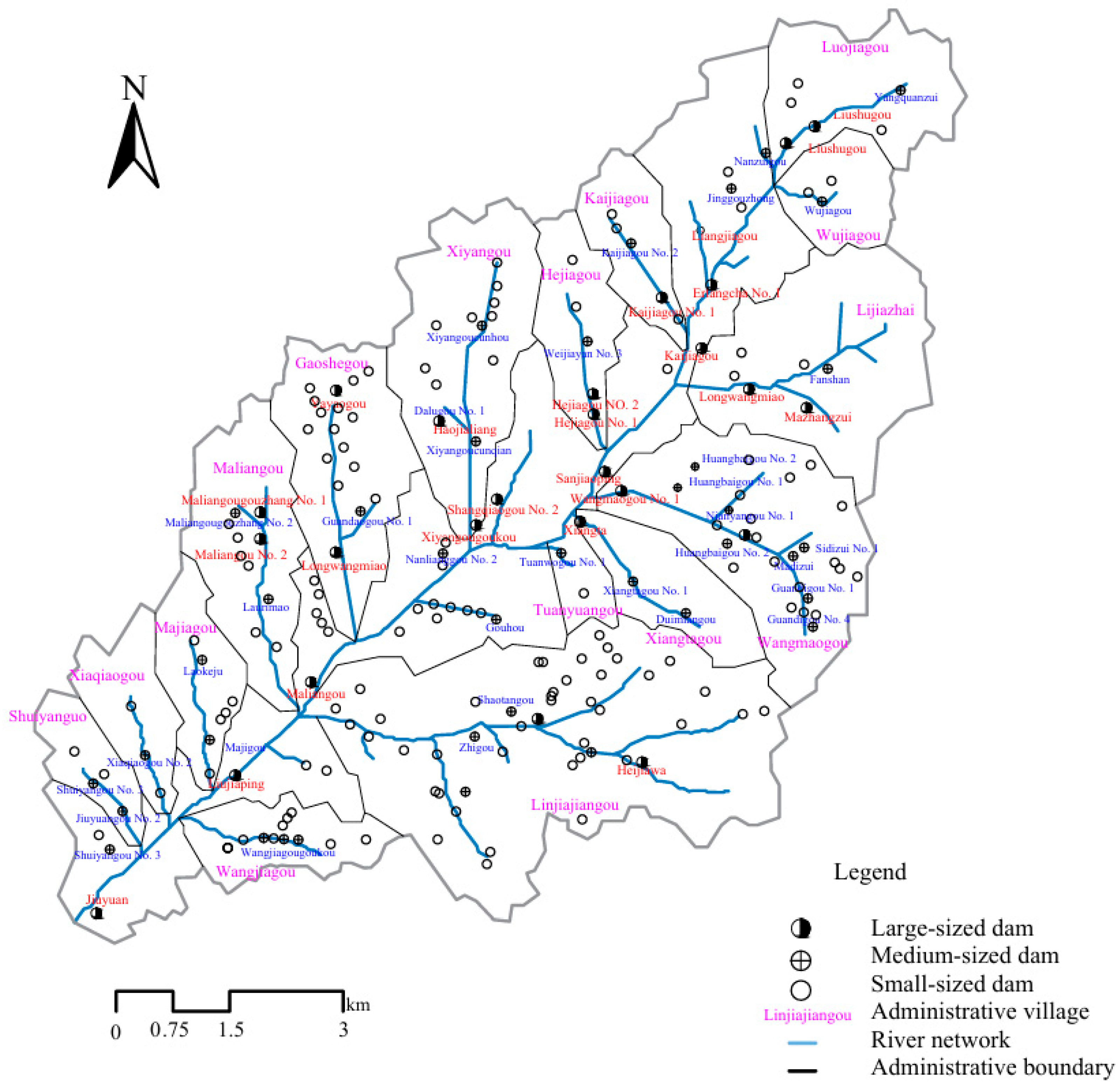

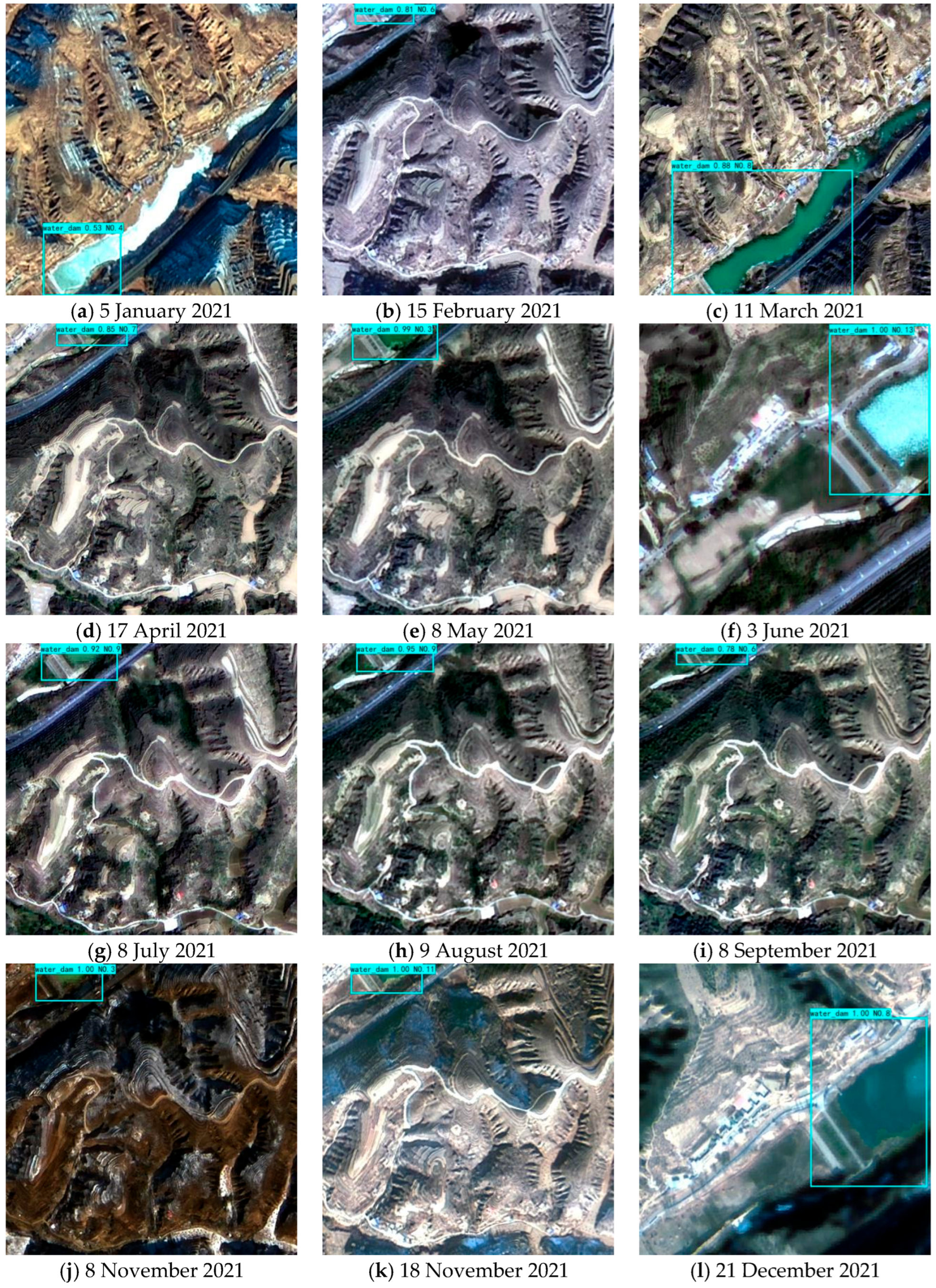

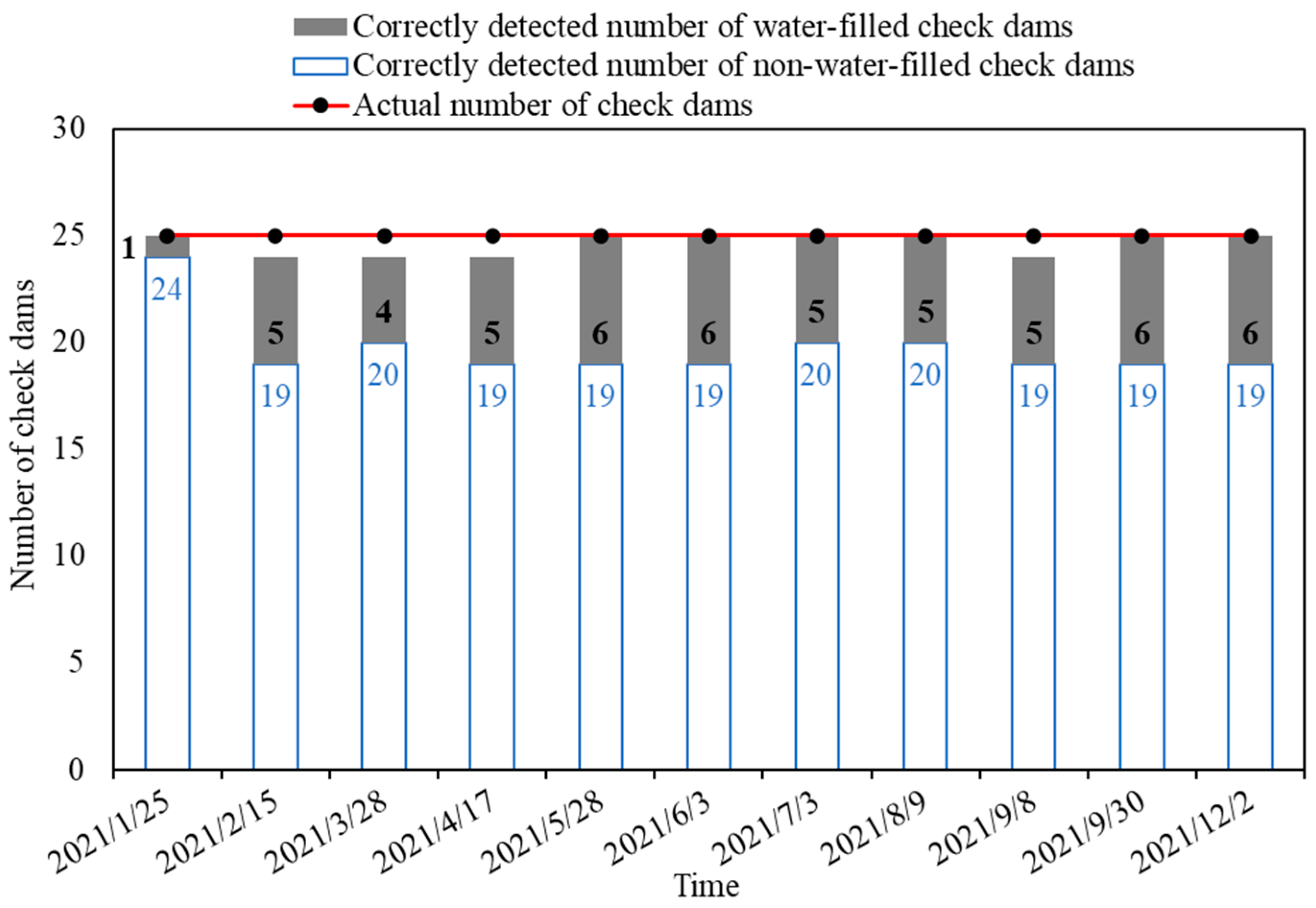

| Parameter | Multi-Class Strategy | Single Class Strategy | |
|---|---|---|---|
| Training epochs | Frozen training | 50 | 50 |
| Unfrozen training | 50 | 50 | |
| Initial learning rate | Frozen training | 0.0005 | 0.0005 |
| Unfrozen training | 0.00005 | 0.00005 | |
| Batch size | Frozen training | 8 | 8 |
| Unfrozen training | 4 | 4 | |
| Datasets | Multi-class target detection dataset (categories include both water-filled and non-water-filled silt dams) | Single-class target detection dataset (category: check dams) | |
| Single-class target detection dataset (category: water-filled check dams) | |||
| Parameter | Multi-Class Strategy | Single Class Strategy | ||
|---|---|---|---|---|
| Precision (P) | Water-filled check dams | 0.9474 | Check dams | 0.8989 |
| Non-water-filled check dams | 0.8056 | Water-filled check dams | 0.9714 | |
| Recall (R) | Water-filled check dams | 0.5806 | Check dams | 0.5839 |
| Non-water-filled check dams | 0.4677 | Water-filled check dams | 0.4789 | |
| F1-Score | Water-filled check dams | 0.72 | Check dams | 0.71 |
| Non-water-filled check dams | 0.59 | Water-filled check dams | 0.64 | |
| Average Precision (AP) | Water-filled check dams | 0.7424 | Check dams | 0.7735 |
| Non-water-filled check dams | 0.5809 | Water-filled check dams | 0.7941 | |
| Mean Average Precision (mAP) | 0.6616 | Check dams | 0.7735 | |
| Water-filled check dams | 0.7941 | |||
| Parameter | Training Model | |
|---|---|---|
| CDDM | WF-CDDM | |
| Precision (P) | 0.99 | 0.99 |
| Recall (R) | 0.74 | 0.84 |
| F1-Score | 0.84 | 0.91 |
| Average Precision (AP) | 0.90 | 0.92 |
| Mean Average Precision (mAP) | 0.90 | 0.92 |
| No. | Acquisition Date | Satellite Model | Sensor | Spatial Resolution |
|---|---|---|---|---|
| 1 | 5 January 2021 | GF1C | Multispectral Camera PMS | 2 m |
| 2 | 15 February 2021 | GF1C | Multispectral Camera PMS | 2 m |
| 3 | 11 March 2021 | GF1 | Multispectral Camera PMS2 | 2 m |
| 4 | 17 April 2021 | GF1 | Multispectral Camera PMS2 | 2 m |
| 5 | 8 May 2021 | GF1C | Multispectral Camera PMS | 2 m |
| 6 | 3 June 2021 | GF2 | Multispectral Camera PMS2 | 0.8 m |
| 7 | 8 July 2021 | GF1 | Multispectral Camera PMS2 | 2 m |
| 8 | 9 August 2021 | GF1B | Multispectral Camera PMS | 2 m |
| 9 | 8 September 2021 | GF1C | Multispectral Camera PMS | 2 m |
| 10 | 8 November 2021 | GF1 | Multispectral Camera PMS2 | 2 m |
| 11 | 18 November 2021 | GF1D | Multispectral Camera PMS | 2 m |
| 12 | 2 December 2021 | GF2 | Multispectral Camera PMS1 | 0.8 m |
| No. | Acquisition Date | Satellite Model | Sensor | Spatial Resolution |
|---|---|---|---|---|
| 1 | 25 January 2021 | GF1 | Multispectral Camera PMS2 | 2 m |
| 2 | 15 February 2021 | GF1C | Multispectral Camera PMS | 2 m |
| 3 | 28 March 2021 | GF1D | Multispectral Camera PMS | 2 m |
| 4 | 17 April 2021 | GF1 | Multispectral Camera PMS2 | 2 m |
| 5 | 28 May 2021 | GF1 | Multispectral Camera PMS2 | 2 m |
| 6 | 3 June 2021 | GF2 | Multispectral Camera PMS1 and PMS2 | 0.8 m |
| 7 | 3 July 2021 | GF1B | Multispectral Camera PMS | 2 m |
| 8 | 9 August 2021 | GF1B | Multispectral Camera PMS | 2 m |
| 9 | 8 September 2021 | GF1C | Multispectral Camera PMS | 2 m |
| 10 | 30 September 2021 | GF6 | Multispectral Camera PMS | 2 m |
| 11 | 2 December 2021 | GF2 | Multispectral Camera PMS1 | 0.8 m |
Disclaimer/Publisher’s Note: The statements, opinions and data contained in all publications are solely those of the individual author(s) and contributor(s) and not of MDPI and/or the editor(s). MDPI and/or the editor(s) disclaim responsibility for any injury to people or property resulting from any ideas, methods, instructions or products referred to in the content. |
© 2025 by the authors. Licensee MDPI, Basel, Switzerland. This article is an open access article distributed under the terms and conditions of the Creative Commons Attribution (CC BY) license (https://creativecommons.org/licenses/by/4.0/).
Share and Cite
Xia, Z.; Yu, S.; Zhang, N.; Wang, J.; Cao, Y.; Yue, F.; Zhang, H. A New Monitoring Method for the Water-Filled Status of Check Dams Using Remote Sensing and Deep Learning Techniques. Water 2025, 17, 2185. https://doi.org/10.3390/w17152185
Xia Z, Yu S, Zhang N, Wang J, Cao Y, Yue F, Zhang H. A New Monitoring Method for the Water-Filled Status of Check Dams Using Remote Sensing and Deep Learning Techniques. Water. 2025; 17(15):2185. https://doi.org/10.3390/w17152185
Chicago/Turabian StyleXia, Zhaohui, Shu Yu, Naichang Zhang, Jianqin Wang, Yongxiang Cao, Fan Yue, and Heng Zhang. 2025. "A New Monitoring Method for the Water-Filled Status of Check Dams Using Remote Sensing and Deep Learning Techniques" Water 17, no. 15: 2185. https://doi.org/10.3390/w17152185
APA StyleXia, Z., Yu, S., Zhang, N., Wang, J., Cao, Y., Yue, F., & Zhang, H. (2025). A New Monitoring Method for the Water-Filled Status of Check Dams Using Remote Sensing and Deep Learning Techniques. Water, 17(15), 2185. https://doi.org/10.3390/w17152185







